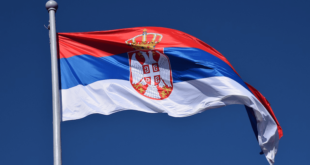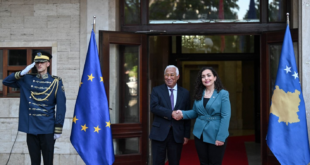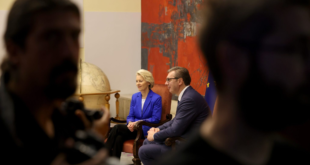written by: Ioannis Michaletos,
Source: worldsecuritynetwork.com
The outlook of Serbia in the field of regional cooperation and border issues, reveals that the country seem eager to implement regional cooperation policies aimed at the so-called “asymmetrical threats” of organized crime, international terrorism, illegal immigration, environmental pollution, money laundering and extremism.
Most of its structures can be labelled as “Eurocentric” with an addition of Euro-Atlantic networks, aiming at integrating into the EU and NATO the Western Balkans in due time.
It seems that Serbia, in terms of its foreign policy, has as a strategic aim to construct a nexus of regional agreements that will ensure a steady flow of communication and interaction with their neighbours so as to be able to comprehend and counteract any perceived threats to their border control that is being affected by asymmetrical threats, such as the ones mentioned.
All the above, come in contact through a series of interlocked peripheral European intergovernmental agreements, that pursues forward towards an inclusion of all the Balkan states in EU and NATO, through the standardization of their foreign policy aims and ethics.
Serbia’s multilateral role
Serbia’s full-fledged participation in regional organisations resumed only after the regime change of October 2000. European and Euro-Atlantic orientation constitutes today the principal direction of Serbia’s foreign policy and in this connection the developing regional cooperation in the Balkans, especially in their western part, is a prerequisite for Serbia’s future accession to the EU, which can become possible between 2014 and 2017. Serbia occupies a central place in the Balkan region. Situated at the crossroads of Europe and the Middle East, it has experienced the influences of both eastern and western civilisations. Recently, regional cooperation has become a prerequisite for Serbia’s EU accession as an externally determined process with rigorous conditions and increasing expectations.
Multilateral regional co-operation falls within the priorities of foreign policy and international relations of Serbia as an instrument and substance of our co-operation with the neighbours in the region as well as within the context of the Serbia inclusion in European integrations, Euro-Atlantic structures and EU.
In the context of Serbia inclusion in multilateral economic and political relations and integrations as well as in the context of globalization, the relations and co-operation of regional character are of importance in the field of liberalization of trade and further affirmation of market economy and free trade.
In that respect, the efforts to turn the region of South Eastern Europe into a free trade zone in which Serbia is actively participating through bilateral negotiations with neighbours and in the region (free trade agreements with Macedonia, Hungary, Bosnia and Herzegovina as well as negotiations with Croatia, Bulgaria, Slovenia and Albania), are of particular importance. Serbia enjoys relatively good relations with its neighbouring countries. The border with Bosnia and Herzegovina along the Drina River continues to be an issue, whilst the issue of independence for Kosovo is of particular concern to Serbia.
Important regional cooperation aspects
1. SOUTH-EAST EUROPE COOPERATION PROCESS (SEECP)
South-East Europe Cooperation Process was initiated in 1996 with a view to transforming South-Eastern Europe into the region of stability, safety and cooperation in line with the European integration processes and through promotion of mutual dialogue and cooperation on all levels and in all areas of common interest. Eleven countries, in the capacity of full-fledged members, participate in the work of the Cooperation Process: Serbia, Romania, Bulgaria, Greece, Turkey, Montenegro, Albania, Bosnia and Herzegovina, Macedonia, Croatia and Moldova. The Chairmanship of the Initiative for the period May 2007-May 2008 has been taken over by Bulgaria. After Bulgaria the chairmanship will be taken by Moldova.
SEECP activities are taking place at Summits of Heads of State and Government, Meetings of Foreign Ministers, as well as on the level of political directors of the Foreign Ministries of the participating states. The Meetings of Troika, as a permanent coordination body comprised of current, former and next chairmen, are also being held. Meetings on the level of departments are being held as necessary and in order to discuss some issues of interest for the member states.
Serbia began fully to participate in the activities of the South-East Europe Cooperation Process at the Skopje Summit in October 2000.
At the Cooperation Process Summit held in Zagreb on 11 May 2007, a decision was taken to establish functional relations between the Process (SEECP) and the newly formed Regional Cooperation Council (RCC), while the Process will continue to play its role of a Forum for Political Dialogue and Direction of Cooperation between Participating States, the RCC Secretariat, based in Sarajevo will serve as an operational support to the Process.
The main document of the South-East Europe Cooperation Process is the Charter on Good-Neighbourly Relations, Stability, Security and Cooperation in South-Eastern Europe, adopted in Bucharest in 2000 (http://www.mvpei/seecp/docs/povelja/SEECP.pdf).
The Charter was amended at the Cooperation Process Summit, held in Zagreb on 11 May 2007, in order to define the relationship between the SEECP and the Regional Cooperation Council.
2. STABILITY PACT FOR SOUTH-EASTERN EUROPE (SP )
Stability Pact for South-Eastern Europe (SP) was established at the initiative of the Federal Republic of Germany, at the time of its EU Presidency, on the occasion of the EU Foreign Ministers’ Meeting, held in Cologne, on 10 June 1999, when the political document ‘’Stability Pact for South-Eastern Europe’’ was adopted. The new initiative was formally confirmed at the Summit held in Sarajevo on 30 July 1999. It became operational at the first meeting of the Regional Table in September 1999.
The main purpose of the SP was a long-term stabilization, security, democratization and economic reconstruction and development of the region aimed at integrating in European and Euro-Atlantic structures (EU, NATO). The task of the SP is to coordinate assistance of the international community to the region in the process of fulfilling the conditions for speedier integration in European and Euro-Atlantic structures.
Partners-participants of the SP are: 9 countries of the region, benefiting from the assistance (Albania, Bosnia and Herzegovina, Bulgaria, Croatia, Serbia, Montenegro, Macedonia, Romania and Moldova), member states of the EU and European Commission, donors, international organizations UN, OSCE, Council of Europe, UNHCR, NATO and OECD, international financial institutions: World Bank, International Monetary Fund, European Investment Bank, European Bank for Reconstruction and Development, Council of Europe Development Bank, etc.
The basic operational structure of the Pact comprises the Regional Table, which coordinates all activities of the SP including three Working Tables: Table I- for issues related to democratization and human rights, Table II-economy and reconstruction and Table III-defence and security with two sub-tables for military and security issues and for justice and home affairs. Meetings of the Regional Table and all the three working tables are being held twice a year. The Stability Pact Secretariat is located at Brussels and the Special Coordinator is the former Austrian Vice-Chancellor Dr. Erhard Busek. Web site: www.stabilitypact.org.
In the past years Stability Pact was a mediator in the implementation of several successful projects with a view to establishing cooperation and linking of countries of the South-East region. An agreed approach has been implemented in several important fields (combating organized crime and corruption), experiences are being exchanged in the field of migration cooperation is being developed between local communities along the border of the SEE countries, today guarded by the police and not the army. Four countries of the Sava River Basin set up the Sava Commission with a view to more efficient resolving of economic and environmental issues in the basin.
The greatest successes have been made in the economic field. This is, primarily, true of the established free trade area in the region (CEFTA-signed in Bucharest on 19 December 2006 and entered into force in June 2007. For Serbia and Bosnia and Herzegovina it will enter into force in September 2007, once the ratification process is completed. Regional Energy Market was also established, compatible with the internal EU market. Agreement on the Establishment of the Energy Community of South-East Europe region (ECSEE) was signed in Athens, on 25 October 2005 and entered into force on 1 July 2006 (Serbia is one of the signatory parties).
In March 2008 the Stability Pact was be replaced by the Regional Cooperation Council (RCC) as the new more focused and more efficient form of regional cooperation within the framework of which the South-East Europe countries will play more active role in line with the concept of the so-called Regional Ownership. The Decision on the transformation of the Pact was confirmed at the SEECP Summit, held in Zagreb on 10 May 2007
3. CENTRAL-EUROPEAN INITIATIVE-CEI
Central-European Initiative (CEI) was established as the result of the ‘’quadrilateral cooperation’’, which was initiated in 1989 by Italy, Austria, Yugoslavia and Hungary, with a view to speeding up Yugoslav and Hungarian EU integration through intensive political and economic cooperation with the developed partners from the neighbourhood. CEI became Pentagonal when Czechoslovakia joined in 1990, i.e. it became Hexagonal when Poland joined in 1991 at the Meeting of the Prime Ministers of the participating states in Dubrovnik. Due to the eruption and intensification of the crisis in the territory of the former SFRY, Yugoslavia did not participate in the work of CEI since that time. Serbia ( then Federal Republic of Yugoslavia) resumed its membership in CEI at the CEI Summit, held in Budapest on 24 November 2000.
There are diverse forms of cooperation within this initiative in terms of its type, content and level of cooperation. Within the CEI there are regular annual summits (heads of state/government, including economic forum) and regular annual meetings of Foreign Ministers while the meetings of national coordinators and Ministers in charge of certain departments are being organized as needed. Activities of the CEI member states include the activities of working groups which are defined by themes (17 in total) and the support to the activities is being provided through the three funds. Parliamentary cooperation is being carried out within the Parliamentary Assembly.
Today, CEI has 18 member states: Austria, Albania, Belarus, Bosnia and Herzegovina, Bulgaria, Croatia, Czech Republic, Italy, Hungary, Macedonia, Moldova, Poland, Romania, Slovakia, Slovenia, Serbia, Ukraine and Montenegro. Unlike other initiatives, CEI has its own funds for financing small-scale projects (the main donor is Italy). Today, CEI has an equal number of EU member and non-member-states (members are also the countries of the so-called European neighbourhood- Belarus, Ukraine and Moldova) which makes this Initiative suitable for the sharing of experience in the process of Euro integration. Like other regional initiatives, CEI is undergoing transformation i.e. looking for a new place and role that would make this initiative compatible with other actors of regional cooperation.
4. ADRIATIC-IONIAN INITIATIVE-AII
Adriatic-Ionian Initiative was established out of the former Adriatic Initiative which was launched by Italy in 1998 with a view to fostering development and coordination of cooperation between littoral countries (Italy, Slovenia, Croatia, Bosnia and Herzegovina and Albania). Since the interest of Greece to participate in this form of regional cooperation was recognized, Adriatic Initiative became the Adriatic-Ionian one at the meeting of Foreign Ministers of the participating states in Ancona in May 2000.
AII activities are taking place within six round tables: table for naval and transport affairs; table for economy: tourism and cooperation between small and medium-sized enterprises; table for the protection of the environment: sustainable development and preservation of resources: for culture: for education and cooperation between universities; for the protection against organized crime.
The highest body is Adriatic-Ionian Council comprising Foreign Ministers of participating states. The Committee of High Officials operationally coordinates and prepares the meetings of foreign ministers.
5. SOUTH-EAST EUROPE COOPERATIVE INITIATIVE-SEECI
South-East Europe Cooperative Initiative (SECI) is a regional initiative initiated by the USA as a support to the implementation of the Dayton Accords. SECI was established in December 1996 at the inaugural session at Geneva on the basis of ‘’Final Points of Common EU-USA Understanding’’, with the purpose of developing sustainable economic strategy in the region. SECI is focused on trans-border cooperation programs and projects in the fields of development of infrastructure, trade and traffic issues, security, energy, environment and development of private sector.
All SECI programs and projects are being implemented by experts from the member states and states supporting this Initiative with the technical support of the European Commission, UN Economic Commission for Europe (UN/ECE), World Bank, European Bank for Reconstruction and Development, European Investment Bank, World Customs Organization and, to certain extent, Organization for Security and Cooperation in Europe (OSCE). Also, SEECI closely cooperates with the Stability Pact, Central European Initiative, Organization of the Black Sea Economic cooperation, specialized UN agencies and programs and other organizations.
SECI member states are: Albania, Bosnia and Herzegovina, Bulgaria, Croatia, Greece, Hungary, Moldova, Macedonia, Romania, Slovenia, Serbia, Turkey and Montenegro.
The principal SECI goals are: elimination of administrative and other obstacles with a view to increasing efficiency in the flow of goods and improved trade, identification of bottlenecks at main international traffic corridors, creation of networks and zones of energy efficiency, investing in the promotion of networks of pipelines and their connections with the international pipelines, provision of funds for the promotion of entrepreneurship, primarily through projects of small and medium-sized enterprises, etc.
As part of the overall activities in regulating normal functioning of cross-border cooperation, cooperation in the filed of combating trans-border crime was also developed within SECI. To that end, an ‘’Agreement on Cooperation to Prevent and Combat Trans-Border Crime’’ was signed in Bucharest on 26 May 1999.
At the same time, the ‘’Charter on Regional SECI Center for Fighting Trans-Border Crime’’ was also signed. The Agreement provides for cooperation between the member states in preventing, discovering, investigating, prosecuting and sanctioning the trans-border crime. In that context, forms of special cooperation between the bodies of the member states are envisaged (information, data exchange, protection of personal data, submission of requests, etc.) Mutual Cooperation Committee has been established as the main body for the implementation of the Agreement. In addition to the representatives of the Member Countries, the representatives of Interpol and World Customs Organization (WCO) are also included in the Committee as “permanent advisors”. Each country in the Committee is represented by two officials: one representative of the customs and one of the police.
5.1. SECI CENTER – REGIONAL CENTER FOR COMBATING TRANS-BORDER CRIME
There is a Regional center within SECI for the prevention and combating trans-border crime located in Bucharest. All Member Countries are represented in the Center through their permanent liaison officers in addition to one representative of the police and one of the customs. The Bucharest Regional Center closely cooperates with the World Customs Organization and Interpol and on the basis of their recommendations it organizes its work. (These organizations enjoy the status of permanent advisors of the SECI Center). The main role of the Regional Centre in Bucharest is to develop an effective cooperation among the governmental departments of the Member Countries in the fields of identification, prevention, investigation and combating trans-border crime through the exchange of information and documents.
Within the SECI Centre each Member Country is responsible for a specific field, for example: Hungary for the problem of stolen vehicles, Albania for customs fraud, Serbia to coordinate the Regional working group of SEE Prosecutors. This is a special initiative aimed at improving cooperation among the prosecutors within SEE region which will contribute to a more efficient fight against trans-border crime, i.e. to the promotion of legal procedural mechanisms for the communication among the prosecutors of the region in accordance with the powers and responsibilities under the Agreement on the Exchange of Information in the Struggle against Organized Crime signed by all SECI Member Countries, as well as under other international treaties.
The SECI Center has entered a new stage, both in respect of its organization and of the sources for financing its activities which is in conformity with the policy of regional ownership and review of the place and role of regional initiatives. These issues are discussed at the meetings of the SECI Joint Cooperation Committee within the two working groups – the Working Group for Budget which harmonizes a new method of financing and the Working Group for the SELEC Convention which has to create a new legal basis and determine mandate for future SECI activities.
6. MIGRATION, ASYLUM, REFUGEES REGIONL INITIATIVE- MARRI
The Stability Pact Migration, Asylum, Refugees Regional Initiative (MARRI) was formed in 2003 by merging the Migration and Asylum Initiative (MAI) and the Regional Return Initiative (RRI) – both established within the Stability Pact for South Eastern Europe.
MARRI Member States are: Albania, Bosnia and Hercegovina, Croatia, Montenegro, Macedonia and Serbia.
MARRI was set up in line with the basic guidelines of the concept of regional ownership. The main idea behind it was that the countries of the Western Balkans take over eventually the initiatives on regional cooperation. In this way the capabilities of the five countries of the Western Balkans to independently cooperate and harmonize their own policies will be put to the test, as well as their capacities to contribute to the development, stabilization and improvement of the situation in the region. Thus, the SEE countries have manifested their readiness to be included into complex European and Euro-Atlantic processes of integration in important fields such as justice and home affairs.
The Migration, Asylum, Refugees Regional Initiative operates through two mechanisms: the MARRI Regional Forum which provides political and general support to the activities of the Initiative and the MARI Regional Centre which puts into practice the MARRI cooperation and activities and supports the implementation of the decisions taken by the Forum.
The Regional Forum engaging ministers and high representatives responsible for the issues of migration, asylum, border management, visa regime and displaced persons, serves also for a better exchange of information, experiences and for making decisions of common interest of its Member States.
The Secretariat, i.e. the MARRI Regional Center was opened in Skopje on 18 November 2004 as a support to the MARRI Regional Forum. The representatives of the Western Balkans take part in the work of the Centre. On the occasion of the establishment of the MARRI Centre, a Memorandum of Understanding was signed in Skopje in early July 2004 on the basis of which the rights and responsibilities of the MARRI Forum Member Countries were transferred within the establishment and operation of the Centre. The Center serves as a Liaison Office for all activities related to migration, asylum and refugees.
7. DANUBE COOPERATION PROCESS
The Danube Cooperation Process (DCP) is a political and diplomatic initiative aimed at giving a new political impetus to the strengthening and development of multilateral relations among Danubian countries, without creating new institutions. All Danubian countries and some EU candidate countries participate in the process based on an initiative launched by Austria, Romania, European Commission and the Stability Pact in June 2001. It was formally established at the First Ministerial Conference held in Vienna on 27 May 2002.
The establishment of the DCP, as a political, diplomatic and economic consultative forum complementary to the existing regional mechanisms and initiatives, contributes to the promotion of cooperation and relations in the Danube region. It is also in line with the Euro Atlantic integration processes. Broadly based and well established DCP platform, interest of key international factors (USA, EU and international organizations), and interest expressed by participating countries in regional and sub-regional forms of cooperation, are main features of the Initiative.
8. ORGANIZATION OF THE BLACK SEA ECONOMIC COOPERATION (BSEC)
The Organization of the Black Sea Economic Cooperation was established at the Summit of the Heads of State or Government of 11 countries of the wider Black Sea Region (Albania, Armenia, Azerbaijan, Bulgaria, Georgia, Greece, Moldova, Romania, Russia, Turkey and Ukraine) in Istanbul on 25 June 1992. Austria, Germany, France, Italy, Poland, Slovakia, Egypt, Tunisia and Israel are in observer status. Turkey has assumed the Chairmanship-in-Office of BSEC for the period May-November 2007.
The principal goal of the Initiative is the development of economic cooperation in the over 350 million people large market and an area of nearly 20 million square kilometers, as well as the promotion of integration of its Member States into international economic processes. This is the region of rich natural resources including large oil and natural gas resources. The majority of the BSEC Members are countries in transition. Activities in creating a favourable political climate for cooperation in the region and the fight against terrorism and organised crime represent an important aspect of BSEC operation.
The meetings of the Council of Ministers of Foreign Affairs, the highest body of the Organization, are held twice a year. The Committee of Senior Officials, as a kind of executive BSEC body, directs the operation of the Organization. There are fifteen working groups within BSEC dealing with the development of concrete projects in specific fields.
The Parliamentary Assembly of BSEC (PABSEC) supports democratic pluralistic structures in the region through its advisory role in a number of fields: BSEC Trade and Development Bank headquartered in Thessaloniki and BSEC Business Council.
9. INTERNATIONAL SAVA RIVER BASIN COMMISSION
Under the auspices of the Stability Pact for Southeastern Europe an initiative has been launched for the implementation of a regional project of rehabilitation of the Sava river basin. The riparian countries: Republic of Slovenia, Republic of Croatia, Bosnia and Herzegovina and the Federal Republic of Yugoslavia signed the Framework Agreement on the Sava River Basin and the Navigation Protocol on 3 December 2002. The Agreement came into force on 29 December 2004. The Agreement was drafted according to the EU Water Framework Directive and it includes also the elements of 1948 Belgrade Danube Navigation Convention and 1994 Sofia Convention on Cooperation for the Protection and Sustainable Use of the Danube River.
On the basis of the Framework Agreement on the Sava River Basin ratified by Serbia (the State Union of Serbia and Montenegro at that time) on 27 May 2004, the International Sava River Basin Commission was established in June 2005 as a permanent working body in charge of the implementation of the Framework Agreement, elaboration of the Sava River Basin Action Plan and adoption of necessary legal acts and Protocols thereto.
Serbia as the most southerly country downstream of the Sava River is particularly interested in moving forward the process of elaboration of the protocols dealing with specific issues (trans-boundary pollution, prevention of pollution by vessels, emergencies, protection against flooding, ground waters, ice, drought, a lack of water).
A typical case of regional cooperation
Joint declaration of cooperation was signed in Belgrade, in 2010, by the head of nine military security, countries of Southeast Europe at a meeting held in the Serbian capital, with the responsibility of the Regional Cooperation Council, under the auspices of the Directorate of Military Intelligence Staff of the European Union (EU).
This is the second meeting of this kind, head of military security services in Southeast Europe. The first was conducted in 2009 in Romania (Bucharest), and the next will be in 2011, Bosnia-Herzegovina. The meeting was attended by a total of 12 countries, 9 of which – Bulgaria, Bosnia-Herzegovina, Croatia, Moldova, Montenegro, Macedonia, Romania, Serbia, Slovenia, signed the joint declaration, while the remaining three – Albania, Greece and Turkey – are expected to sign on, then the relevant considerations to be made within the competent institutions of each country.
The joint declaration signed on cooperation between military security services of countries of Southeast Europe which are members of the Regional Cooperation Council (RCC). The countries that signed the joint statement agreed that they should consolidate and further develop cooperation in all Regarding the security threats and make efforts to improve the exchange of relevant information at the regional level.
 Eurasia Press & News
Eurasia Press & News



